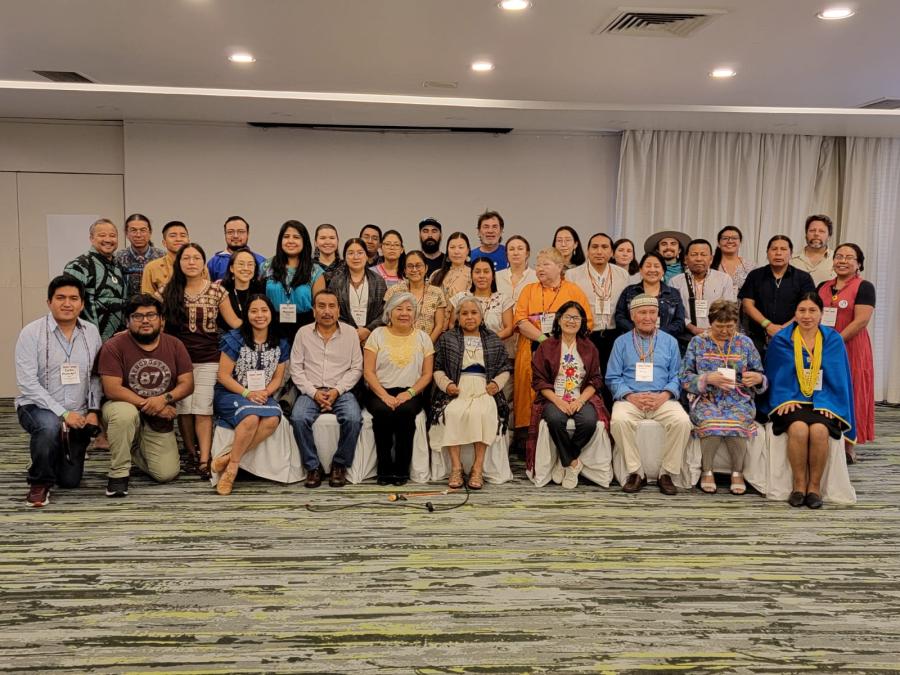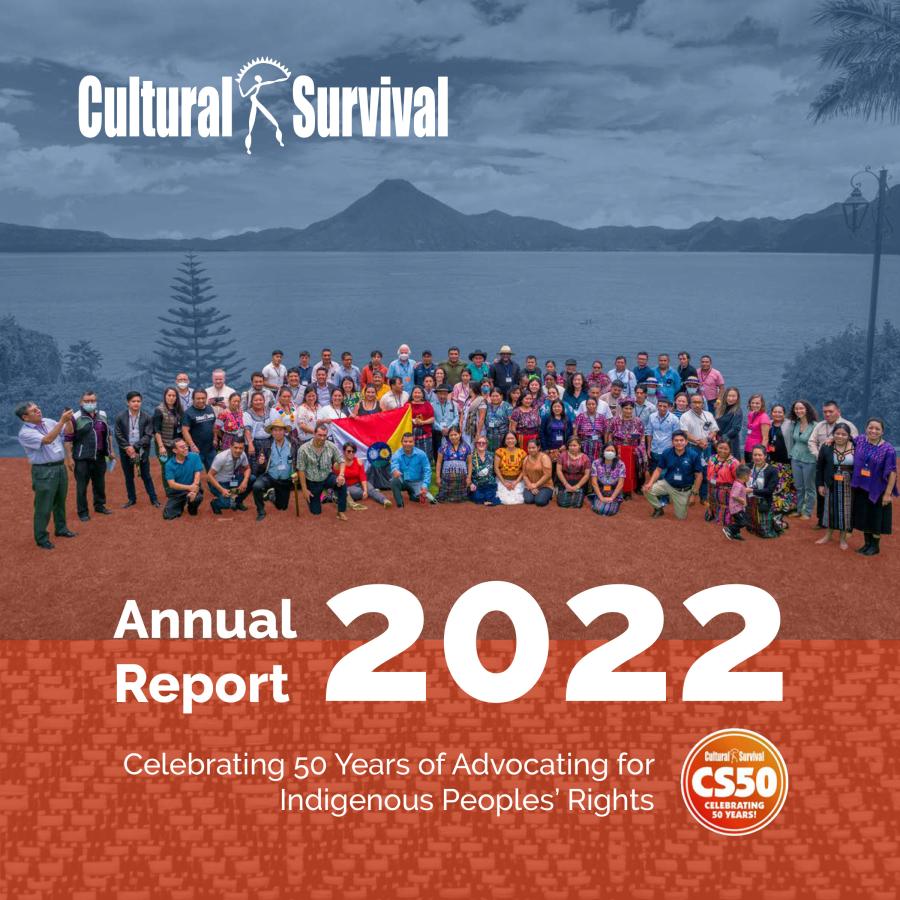On December 31, the first International Decade of the World’s Indigenous People will come to an end. For this edition, Cultural Survival Quarterly asked indigenous people from around the globe to take stock of what was achieved and what remains to be done. In doing so, we set no criteria for measuring the Decade’s “success.” Nonetheless, the indigenous voices in these pages are unanimous that the accomplishments were far outweighed by what has been left for the future.
The principle goal of the International Decade, as stated in General Assembly Resolution 48/163, was “strengthened international cooperation for the solution of problems faced by indigenous people in such areas as human rights, the environment, development, education and health.” Measured by the standard of “strengthened international cooperation,” no one would argue that the Decade was a failure. Ten years ago there was no indigenous-led United Nations Permanent Forum on Indigenous Issues, no Special Rapporteur on the situation of the human rights and fundamental freedoms of indigenous people to whom indigenous peoples could direct complaints, and no staff or internal coordination within the U.N. bureaucracy to assist indigenous peoples who raise concerns within the United Nations and its Specialized Agencies.
Indigenous people are now a regular presence at international meetings on the environment, health, human rights, and globalization. They are visible in the halls of the United Nations, in both Geneva and New York. During 2004, which the Permanent Forum dedicated to indigenous women, indigenous women were invited to meet with members of the Security Council to discuss their concerns.
But is “strengthened international cooperation” the best measure of “success”? The second objective of the International Decade was for “international and national agencies, as well as communities and private enterprises, [to] devote special attention to development activities of benefit to indigenous communities.” Yet, throughout these pages, indigenous people report that in terms of development, they are no better, and in some cases, worse off than they were 10 years ago. Even indigenous people from First World countries such as Canada, which made strides during the International Decade to address indigenous issues, describe living conditions in their communities that would be considered deplorable even in the Third World. According to Adelard Blackman of the Buffalo Creek Dene Nation of Northern Canada, “Our people live in reserves that have 80 to 90 percent unemployment, massive housing shortages, chronic health problems, education cutbacks, et cetera.” Similar frustrations are echoed by indigenous people from South America, Asia, Africa, and the Pacific.
The third objective of the Decade “is the education of indigenous and non-indigenous societies concerning the situation, cultures, languages, rights, and aspirations of indigenous people.” While the universe of people inside the halls of the United Nations may have gained some awareness of indigenous cultures and concerns, awareness has not trickled down to the public at the national and local levels. To the extent that non-indigenous people are aware that indigenous peoples exist at all, they tend to appear as a blur of “otherness,” rather than as hundreds of ethnically and linguistically distinct peoples, each with their own worldviews and beliefs, means of providing for themselves and their children, knowledge of their environment, forms of artistic expression, and traditions for solving problems. For some non-indigenous people, indigenous peoples are tourist attractions or sources for unusual art or artifacts; for others, they are backward peoples, frozen in their ancient traditions and in need of modernization; for still others, they are living reminders of the historic guilt felt on account of Western exploration, conquest, and colonization.
Almost no non-indigenous people learn indigenous languages. Few non-scholars seriously study indigenous art forms or cultural practices, and those who do tend to be regarded by other non-indigenous people as “trying to find themselves” or “weird.” The media still rarely cover indigenous issues, and when they do it is often in connection with actions many non-indigenous people find threatening. Stories with headlines like “Where the Incas Ruled, Indians are Hoping for Power,” which appeared on page A3 of The New York Times on July 17, fuel fears that indigenous peoples are trying to wrest power from their non-indigenous “betters,” or take revenge for past wrongs. In fact, as Theodore Macdonald’s essay in this issue emphasizes, what indigenous peoples want most is to participate fully and effectively in the governmental processes that impact their lives, without losing their own cultural identity.
Even non-governmental human rights organizations tend to ignore the concerns of indigenous peoples. As Ana Pinto points out, in her work on indigenous rights issues in India she has “had to fight for space, indeed for every word, with other human rights NGOs, including women’s rights groups and children’s rights groups that I thought would have been interested in indigenous women’s and children’s rights.” For Pinto, part of the explanation lies in the fact that mainstream human rights NGOs, like states, are part of a homogenous international political structure, whereas, “the indigenous peoples movement fundamentally questions the concept of the state as it exists today.”
The fourth objective of the International Decade encapsulates the central aspiration of indigenous peoples everywhere: “the promotion and protection of the rights of indigenous people and their empowerment to make choices which enable them to retain their cultural identity while participating in political, economic, and social life, with full respect for their cultural values, languages, traditions and forms of social integration.” As many of the indigenous peoples whose words appear in this volume point out, at the end of the decade this statement remains far more one of aspiration than reality.
The next two objectives, relate to the implementation of recommendations pertaining to indigenous people of all high-level international conferences (for example, the World Conference on Population and Development and the World Summit for Social Development); and the adoption of the Draft United Nations Declaration on the Rights of Indigenous People. Foot-dragging on these two objectives constitutes, in the eyes of many indigenous peoples, the greatest failure of the International Decade. Certainly, indigenous peoples had the right to expect that more than two out of the 45 articles in the Draft Declaration would have been adopted by the last three months of the Decade. They also had the right to expect that the many resolutions states endorsed at international conferences while brethren states looked on would have been acted on at home. If we measure either of these objectives based on the final goal of the Decade—“that the objectives of the Decade … be assessed by quantifiable outcomes that will improve the lives of indigenous people”—the outcome may be quantifiable, but the result is abysmal.
Yet, in one subjective sense illustrated in the pages of this volume, the International Decade was a tremendous success. Nearly every indigenous activist who wrote or was interviewed for this issue expressed gratitude for the forward strides made, and optimism about the future. As many have repeated, it would have been impossible to correct 500 years of injustice in a decade. Indigenous people are looking ahead to the two remaining meetings this year of the Working Group on the Draft Declaration on the Rights of Indigenous Peoples and hope that the participating states will be motivated to complete their work before the Decade ends. They are hopeful that the General Assembly will follow ECOSOC’s unanimous recommendation to establish a second International Decade of the World’s Indigenous People, and that the Permanent Forum on Indigenous Issues will in time evolve, in the words of Victoria Tauli-Corpuz, “into a permanent worldwide structure for the protection of indigenous peoples.”
Most of all, indigenous peoples hope that the sovereign states that govern the territories on which they live will honor their obligations to indigenous peoples including (1) respecting their basic human rights including their right to self-determination; (2) ensuring that they have the means to participate fully and permanently as citizens in local and national political processes that impact their lives; (3) providing them with the opportunity to give—or not give—their free, prior, and informed consent before development projects are foisted upon them or resources are extracted from their lands; and (4) making available to them the education and training they need to defend their rights, participate in civil society, and make informed decisions about their futures.
Finally, indigenous peoples hope that non-indigenous people will take the International Decade’s third objective seriously. Before governments, particularly democratically elected governments, will take indigenous issues seriously, those issues must become mainstream parts of the national and international political debate. As Adelard Blackman told me in his interview, the International Decade “was one of the quietest decades as far as indigenous peoples were concerned.” It is time to make noise and to put the issue of indigenous rights on the human rights map—on the human map. It is up to all of us —indigenous and non-indigenous peoples alike — to bring the concerns of indigenous peoples to the fore so that the objectives of the International Decade will be realized before another decade passes.



